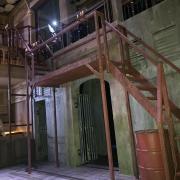
Bordering the heart of London, lies 2500 acres of pure nature - a paradise of plants and animals from the ancient towering trees rustling their leaves in the sun to the varieties of birds chirping away to the mother deers protecting their young.
Richmond Park is most famous for the diverse wildlife it has. In particular, the deer that roam freely around grazing on grass contently. Many people, locals and tourists alike, flock to the park to wonder at the 630 red and fallow deer that have been enjoying this large area of land since 1637. For example, a visitor, named Linda Martin, ‘normally visits during the week’. She likes the ‘open space and the deer’ as do ‘lots of people of all ages’ - there are ‘children and dogs and families’. During the Autumn, it is breeding season where the male deer roar and clash their antlers to fight off rivals and attract females while Spring brings the birth of many young who are then protected and hidden amongst the bracken and long grass by their mothers until they are ready to experience the park alone.
Above land, birds soar across the sky enjoying the fresh air and the many ancient trees they can nest in. Sharantit G. Aurn, a local, described that she visits ‘once or twice a week - especially on Friday’. On Friday morning, 9.30 to 13.00 she attends the bird watching group where they enjoy the 144 species of bird present in the park such as woodpeckers and kestrels.
During the night, when the swarms of visitors have left, Richmond Park continues to be buzzing with life. Many bats spread their wings and fly through the dark night sky. In fact, a trapping survey conducted by a top bat expert, which took place across ten nights, claimed there were nearly 150 bats of 8 species.
This Royal Park has a protected status as an important habitat for wildlife where it has thousands of insect species. In particular, the rare Double Line Moth found only in this park, Bushy Park and Wimbledon Common in the whole of South East England - making this the go to park for all eager naturalists.
Towering above absorbing the sunlight are the 1,200 ancient trees home to a range of wildlife. In particular, the stag beetle - Britain’s largest beetle which can grow up to an impressive 7cm long.
At one end of the park, lies a 40 acre woodland with nothing but wildlife - Isabella Plantation. Isabella Plantation has been enjoyed by visitors since 1953 due to the diverse range of nature. For example, in this green haven, over 70 species of bird can be seen flying through the sky. Lower down on the ground, visitors can examine the 40 species of fungi that live undisturbed in this wonderful woodland. Additionally, as much as 130 species of butterflies and moths can be seen fluttering their delicate wings that can have a variety patterns making an extraordinary spectacle.
Situated on the highest point of Richmond Park, Pembroke lodge sits stately enjoying spectacular views of London. Around this Georgian Mansion, park users can take a stroll around the 13 acres of land on the paths that wind round the many natural spectacles, from interesting shapes of tree trunks to brightly coloured flowers to beautiful views to gaze at from this point. Located within the gardens around Pembroke Lodge, is a steep mound known as King Henry’s mound. This was traditionally thought to be the spot where King Henry VIII stood to watch a rocket fired from the Tower of London. Now, people flock there to use the telescope to have the privilege of viewing an undisturbed view of St Paul’s Cathedral. Pembroke lodge also keeps up with the modern world - upon stepping inside you are greeted with elegant tea rooms with a wide choice of seating area and plenty of drinks and refreshments to enjoy. For example, Sevgi Erten, a regular visitor of Pembroke Lodge, described there as being ‘great views across’. She enjoys the tea rooms with her family as it is ‘a nice place to sit down and relax’ and ‘there are delicious cakes on offer’. In the last 50 years, they have also hosted many weddings, and according to a major wedding site, they are the number one location in the UK.
Richmond Park presents an ideal place for families to enjoy a stroll around the park while breathing in the fresh air and taking in the wonders of the wildlife from their beauty to the variety of sounds they make. For example, Sally Webster, a park user who travels from Devon to see her family ‘five times a year’ described the park as being ‘nice for a general walk’ and that she ‘comes sometimes with her grandchildren’ to enjoy the park.
Richmond Park offers the perfect place for everyone - from those interested in nature to those wanting a space to relax in to those enjoying the park with family.
































